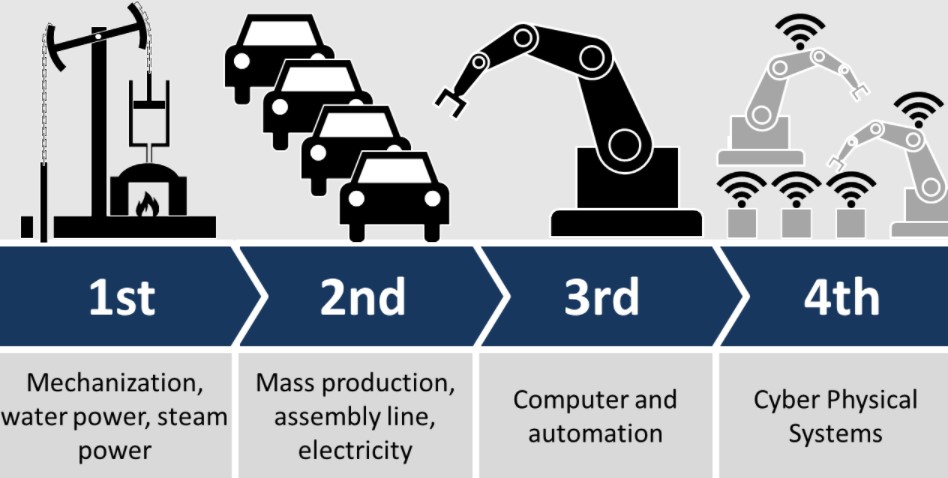Fourth industrial revolution
|
This illustration of Industry 4.0 summarises the four industrial revolutions. |
Contents |
[edit] Introduction
The fourth industrial revolution (also referred to as Industry 4.0 or Industrie 4.0) is a term used to describe the shift away from digitally automated manufacturing and industrial processes (that require human control) to smarter technologies that rely less on human intervention. The technologies of the fourth industrial revolution depend on machine-to-machine communications and the Internet of Things (IoT) to monitor and analyse operations within the manufacturing, industrial and business sectors.
[edit] Review of industrial revolutions
Since the mid-18th century, industrial revolutions were seen as periods where many new inventions led to significant changes in culture, infrastructure, business and related social advances. Each industrial revolution was characterised by specific innovations, including:
- First industrial revolution. Steam and water power were used to mechanise production.
- Second industrial revolution (also referred to as the technological revolution). Electricity was used to support mass production through the use of assembly lines.
- Third industrial revolution (also referred to as the digital revolution). Electronics and information technology have been used to digitise and automate processes.
- Fourth industrial revolution. Cyber physical systems (CPS) are used to enhance automation and connectivity introduced during the third industrial revolution.
[edit] History
In 2011, the term Industrie 4.0 (also referred to as I4.0 or I4) was introduced to describe an innovative computerised manufacturing strategy used by the German government. The term was introduced that year at the Hannover Fair.
Exploration of the concept was continued by the German government’s working group on Industrie 4.0. In October 2012, the group presented the German government with Industrie 4.0 implementation recommendations as a result of its work, and the final report of the group was presented at the Hannover Fair in 2013.
In 2015, the concept of the fourth industrial revolution was introduced at the World Economic Forum (WEF) by the German engineer and economist, Professor Klaus Schwab. Schwab (who is also the founder and executive chairman of the World Economic Forum), characterised the idea as a fusion of new technologies, blurring the lines between the physical, digital and biological worlds.
Mastering the Fourth Industrial Revolution was picked up as the theme of the WEF Annual Meeting in 2016. Its impact became one of the central themes of the WEF in 2017.
[edit] The fourth industrial revolution and the built environment
Mark Farmer's 2017 report, 'Modernise or die', looked forward to a fourth industrial revolution underpinned by cyber-physical smart production techniques, which it described as Industry 4.0. However, Farmer’s report acknowledged that in many respects, construction has yet to achieve Industry 3.0 status, which simply requires large scale use of electronics and IT to automate production.
Based on the progress of Industry 4.0, others suggest that the world might see the biggest industrial shifts in a generation, changing the way people work and live in the urban environment. As a result of greater technological advances, the built environment could see the physical world become ever more connected to the digital one through billions of sensors feeding back information through the IoT. This could result in new ways of serving customers, new capabilities in production and changes in the operation of devices across all sectors. Innovations such as 3D printing, artificial intelligence and advanced robotics could shift models of work and production in ways that are impossible to fully predict.
[edit] Related articles on Designing Buildings
- Are we doing the right thing? Shaping well-being into the future of our urban communities
- Can we build cities that anticipate the future?
- Internet of things.
- Modern methods of construction.
- Modernise or die.
- The Fourth Industrial Revolution is about to hit the construction industry. Here’s how it can thrive.
- The future of the built environment in a revolutionary age.
- The promise and peril of digital cities.
Featured articles and news
Infrastructure that connect the physical and digital domains.
Harnessing robotics and AI in challenging environments
The key to nuclear decommissioning and fusion engineering.
BSRIA announces Lisa Ashworth as new CEO
Tasked with furthering BSRIA’s impressive growth ambitions.
Public buildings get half a million energy efficiency boost
£557 million to switch to cleaner heating and save on energy.
CIOB launches pre-election manifesto
Outlining potential future policies for the next government.
Grenfell Tower Inquiry announcement
Phase 2 hearings come to a close and the final report due in September.
Progress from Parts L, F and O: A whitepaper, one year on.
A replicated study to understand the opinion of practitioners.
ECA announces new president 2024
Electrical engineer and business leader Stuart Smith.
A distinct type of countryside that should be celebrated.
Should Part O be extended to existing buildings?
EAC brands heatwave adaptation a missed opportunity.
Definition of Statutory in workplace and facilities management
Established by IWFM, BESA, CIBSE and BSRIA.
Tackling the transition from traditional heating systems
59% lack the necessary information and confidence to switch.
The general election and the construction industry
As PM, Rishi Sunak announces July 4 date for an election.
Eco apprenticeships continue help grow green workforce
A year after being recognised at the King's coronation.
Permitted development rights for agricultural buildings
The changes coming into effect as of May 21, 2024.























